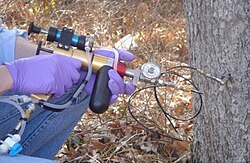Asian Longhorned Beetle Insecticide Treatments
 |
Animal and Plant Health Inspection Service U.S. DEPARTMENT OF AGRICULTURE |
Asian Longhorned Beetle Insecticide Treatments[edit]
The U.S. Department of Agriculture’s (USDA) Animal and Plant Health Inspection Service (APHIS) and its partners use insecticide treatments as part of an integrated approach to eradicate Asian longhorned beetle (ALB). This combined approach includes imposing quarantines, conducting tree inspections, removing infested trees, and sometimes removing at-risk host trees.
Why is insecticide used to fight ALB?[edit]
We use insecticide to reduce the spread of ALB from currently infested areas. It kills beetles that feed on the leaves and twigs of treated trees. It is also effective against the early larval stages of the beetle that feed on the inner, growing layer of the tree. As a result, the insecticide treatments decrease the number of beetles in an area and prevent new trees from becoming infested.
What insecticide does the ALB program use?[edit]
The generic name of the insecticide is imidacloprid. It is a systemic insecticide commonly used to control both agricultural and residential insect pests, such as aphids, cockroaches, termites, soil insects, thrips, whiteflies, and some beetles. It is also used in flea and tick prevention products for pets, and it has been sold in the United States since 1994. Imidacloprid is registered with the U.S. Environmental Protection Agency (EPA) under the Federal Insecticide, Fungicide, and Rodenticide Act and is approved for ALB eradication program use.
When does the ALB program use insecticide treatments on trees?[edit]
When deciding whether to treat trees with imidacloprid, APHIS and State officials consider several important factors, including environmental and biological issues, the scale of an infestation, recent ALB survey results, and cost. Insecticide treatments are used only on trees that are not known to be infested. The treatment kills beetles or larvae that try to feed on the tree and helps prevent it from becoming infested.
How are insecticide treatments used?[edit]
The insecticide is used according to product label requirements and is applied through either tree trunk or soil injections. Trunk injections are applied directly into the tree trunk using a specialized device. Soil injections are applied directly into the soil at the base of trees. The number of injections (either trunk or soil) per tree depends on the size of the tree. With each method, the tree’s vascular system pulls the insecticide upward into the stems, twigs, and foliage where beetles will encounter it as they feed and lay eggs.
What species of trees are treated with insecticide?[edit]
Tree species that could receive treatments include maple and box elder, horse chestnut and buckeye, mimosa, birch, katsura tree, ash, golden raintree, sycamore and London planetree, poplar, willow, mountain ash, and elm. Once an area is identified for treatments, it is most effective to treat all host trees within that area.
When do applications take place?[edit]
Imidacloprid treatments can be effective against ALB when applied in the spring, early summer, or fall—either before adult beetle emergence or when adults are feeding and laying eggs. It takes 1 to 3 weeks by trunk injection and up to 3 months by soil injection for imidacloprid to distribute throughout the tree, depending on the tree’s size and health and on weather conditions.

Can insecticide be used to treat infested trees instead of removing them?[edit]
Unfortunately, no. Variability in treatments, weather conditions, and overall tree health can result in uneven insecticide distribution within a tree and prevent the insecticide from killing all ALB in an infested tree. Also, the insecticide is not effective against the later larval stages that spend most of their time inside the heartwood of the tree where treatment will not reach them. These larvae can continue to grow inside the treated tree, develop, and still emerge as adult beetles. All infested trees must be removed because that is the most effective way to completely eliminate the beetle. Even treated trees are removed and destroyed if they are later found to be infested.
What research has been done on the use of imidacloprid to control ALB?[edit]
USDA and Chinese researchers conducted lab and field tests in China and the United States. Out of multiple insecticides tested, imidacloprid proved to be most effective. Specifically, the testing indicated that imidacloprid was effective against adult beetles as they feed on small twigs and against young larvae as they feed beneath the bark. Imidacloprid has been very well studied for other uses as well, with many articles published in international, peer-reviewed scientific journals.
How will these treatments affect the environment?[edit]
Imidacloprid treatments are applied per product label requirements designed to protect human health and the environment. The precise placement of injection treatments and the measures used to ensure precision during applications help prevent potentially adverse environmental effects. Also, imidacloprid residues are limited to the treated tree and its root area. The degradation process, or natural breakdown of these residues, further minimizes any impact on the environment.
Can imidacloprid harm bees? And are there alternatives?[edit]
EPA issued a preliminary risk assessment for imidacloprid suggesting that some aerial applications may harm bees. The risk assessment did not show any adverse effects to bees from tree trunk or soil injections. USDA conducted a study in Massachusetts and New York that demonstrated applications made to control ALB do not expose bees to harmful levels of imidacloprid. We continue to evaluate alternatives, but at this time none are as effective against ALB as imidacloprid.
For More Information[edit]
To learn more about imidacloprid, go to pubchem.ncbi.nlm.nih.gov/compound/imidacloprid.
For more information on ALB, visit www.aphis.usda.gov/pests-diseases/alb.
USDA is an equal opportunity provider, employer, and lender.
PPQ-22-004 | Issued March 2022
![]()
This work is in the public domain in the United States because it is a work of the United States federal government (see 17 U.S.C. 105).
![]()
Public domainPublic domainfalsefalse
